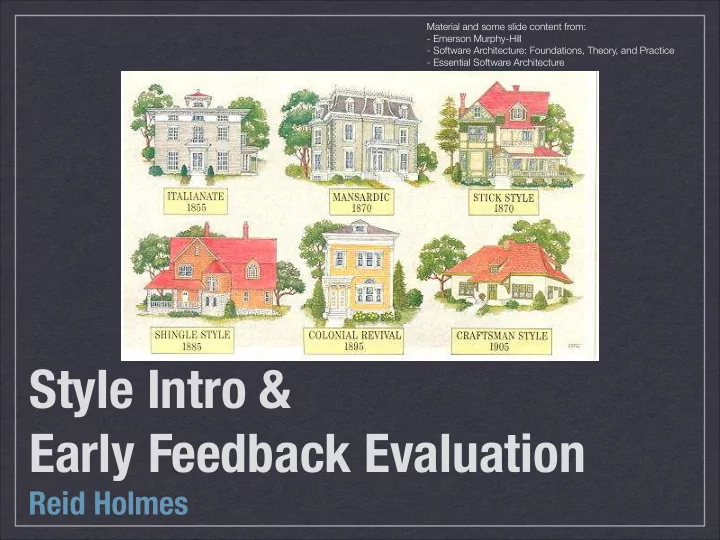

Material and some slide content from: - Emerson Murphy-Hill - Software Architecture: Foundations, Theory, and Practice - Essential Software Architecture Style Intro & Early Feedback Evaluation Reid Holmes
[TAILOR ET AL.] Architectural styles ‣ Some design choices are better than others ‣ Experience can guide us towards beneficial sets of choices (patterns) that have positive properties ‣ An architectural style is a named collection of architectural design decisions that: ‣ Are applicable to a given context ‣ Constrain design decisions ‣ Elicit beneficial qualities in resulting systems REID HOLMES - SE2: SOFTWARE DESIGN & ARCHITECTURE
[TAILOR ET AL.] Architectural styles A set of architectural design decisions that are ‣ applicable to a recurring design problem, and parameterized to account for di ff erent software development contexts in which that problem appears. � e.g., Three-tier architectural pattern: ‣ REID HOLMES - SE2: SOFTWARE DESIGN & ARCHITECTURE
[CZARNECKI] Architectural styles ‣ Defines a family of architectures that are constrained by: ‣ Component/connector vocabulary ‣ Topology ‣ Semantic constraints ‣ When describing styles diagrammatically: ‣ Nodes == components (e.g., procedures, modules, processes, databases, …) ‣ Edges == connectors (e.g., procedure calls, events, db queries, pipes, …) REID HOLMES - SE2: SOFTWARE DESIGN & ARCHITECTURE
[CZARNECKI] Good properties of an architecture ‣ Result in a consistent set of principled techniques ‣ Resilient in the face of (inevitable) changes ‣ Source of guidance through product lifetime ‣ Reuse of established engineering knowledge REID HOLMES - SE2: SOFTWARE DESIGN & ARCHITECTURE
[CZARNECKI] “Pure” architectural styles ‣ Pure architectural styles are rarely used in practice ‣ Systems in practice: ‣ Regularly deviate from pure styles. ‣ Typically feature many architectural styles. ‣ Architects must understand the “pure” styles to understand the strength and weaknesses of the style as well as the consequences of deviating from the style. REID HOLMES - SE2: SOFTWARE DESIGN & ARCHITECTURE
[TOPOLOGY FROM TAILOR ET AL.] Architectural Styles Language Layered Dataflow Peer-to-Peer Based Object- Client Pipe-and-Filter oriented Server Main program & Virtual Batch- Subroutines Machine sequential Shared Implicit Interpreter Memory Invocation Publish- Rule-based Interpreter subscribe Mobile Blackboard Event-based code REID HOLMES - SE2: SOFTWARE DESIGN & ARCHITECTURE
IN CLASS REID HOLMES - SE2: SOFTWARE DESIGN & ARCHITECTURE REID HOLMES - SE2: SOFTWARE DESIGN & ARCHITECTURE REID HOLMES - SE2: SOFTWARE DESIGN & ARCHITECTURE REID HOLMES - SE2: SOFTWARE DESIGN & ARCHITECTURE
Outline ‣ Feedback on early evaluation forms ‣ Map activities back to intended learning outcomes Critique an existing architecture or design. ‣ Di ff erentiate how various architectural styles and ‣ design patterns enhance and degrade a system’s functional-and non-functional properties. Generate and justify and architecture and/or design ‣ given a collection of requirements. Produce and present concise and unambiguous ‣ architecture and design descriptions. Create and implement an architecture and design, ‣ refining it into a complete system. REID HOLMES - SE2: SOFTWARE DESIGN & ARCHITECTURE
Early Evaluation Feedback ‣ What will be on the final exam? ‣ Any content posted to the course web page ‣ Slides [easy questions] ‣ Videos [easy questions] ‣ Any content covered in class [hard questions] ‣ The projects will not be evaluated (directly) REID HOLMES - SE2: SOFTWARE DESIGN & ARCHITECTURE
Early Evaluation Feedback ‣ Recap videos in class. ‣ Why not more examples in the videos? ‣ Video quality / takes / editing concerns. ‣ Course feels too app centric ‣ Why multiple platforms? REID HOLMES - SE2: SOFTWARE DESIGN & ARCHITECTURE
1/4 Architectural Analogy ‣ Kitchen design activity. ‣ What are the architectural components? ‣ How are they related to each other? ‣ What connectors exist? ‣ Why did you choose they components / connectors / topology you did? ‣ How do the connectors bind the components? ‣ Why is software arch. like traditional arch.? ‣ Why is software arch. not like traditional arch.? REID HOLMES - SE2: SOFTWARE DESIGN & ARCHITECTURE
2/4 Architectural Decomposition ‣ Generate an architecture for an automated shopping cart . ‣ Identify the key components and connectors. ‣ Derive a system topology. ‣ Justify your decomposition. ‣ Why these components? ‣ Does the architecture adequately capture the broad system goals? ‣ What are the strengths and weaknesses of the proposed architecture? REID HOLMES - SE2: SOFTWARE DESIGN & ARCHITECTURE
3/4 Architectural Tradeoffs ‣ Generate an architecture for a context-aware notification system. ‣ Identify NFPs for a given stakeholder. ‣ Justify why those NFPs matter. ‣ Determine how those NFPs influence the architecture of the system. ‣ Compare the architectures derived when di ff erent stakeholders care about divergent NFPs. REID HOLMES - SE2: SOFTWARE DESIGN & ARCHITECTURE
4/4 Completeness & Consistency ‣ The Spec is Right. ‣ For a given system description, can we identify: ‣ Aspects that are inconsistent ‣ Aspects that are incomplete ‣ How can we build a description that all stakeholders can understand and reason about? ‣ What is the right level of abstraction for an architectural document? ‣ What tools and techniques can help us generate complete and consistent system descriptions? REID HOLMES - SE2: SOFTWARE DESIGN & ARCHITECTURE
Recommend
More recommend